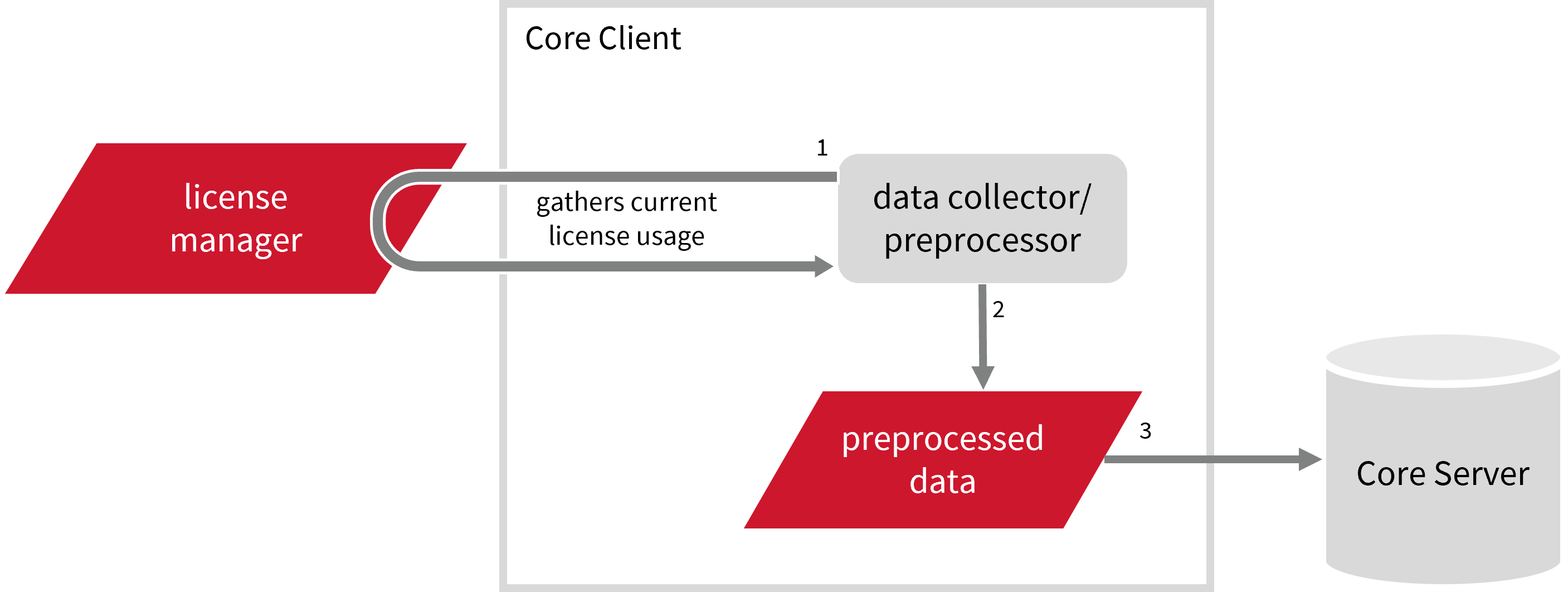We’re upgrading your documentation experience!
A new doc website is live at docs.openit.cloud — a temporary preview during our transition. This website is now in maintenance-only mode (only critical issues will be addressed).
Explore the new website and send us your feedback!
#
LicenseAnalyzer Level 1
#
Introduction
Open iT clients collect data from license servers or data sources, convert it to a format that Open iT can read, and send it to the Core Server for processing and storage in a suitable format for reporting.
#
License Usage Data Collection
License usage data collection consists of two distinct methods:
license manager utility polling log file parsing
The Core Server processes the client data at predefined intervals, storing it in its database, which you can utilize for generating the following types of reports:
- Concurrent Usage Reports - These reports provide detailed insights into the number of simultaneous users accessing the application at any given time. They analyze concurrent usage patterns, providing a clearer understanding of peak usage periods and overall system load.
- Elapsed Time Reports - These reports summarize the total time taken for each application execution. By displaying the duration of each process, they facilitate in-depth analysis of application performance and help identify areas for improvement.
- Denial Reports - These reports provide a comprehensive view of license request denials, including details such as the reasons for denial, the time periods in which denials occurred, and any trends or patterns within the data.
- Real-time Reports (License Monitor / License Monitor Portal) - These web-based reporting tools display the real-time monitoring interface of all the collected data from various supported license managers.
Additionally, Level 1 supports other data tailored to specific use cases for some applications or systems, such as usage for:
- Reserved Licenses - licenses allocated to specific users or systems and cannot be shared or reassigned without administrative intervention.
- Lingering Licenses - borrowed licenses. A temporary mechanism in which a license remains "checked out" for a short period after a user has stopped using the software.
- Token-based Licenses - a flexible licensing model where "tokens" are purchased and consumed for specific features or software usage.
- Named User Licenses - licenses assigned to specific users.
- Dongle Licenses - licenses that require a physical hardware device (dongle) to be connected to the computer to enable software use.
#
License Manager Utility Polling
For this collection, if an Open iT client is installed in your license server, the data collector/preprocessor gathers the current license usage information from the license manager every hour using a 5-minute sample interval, triggering the data collection process. It also processes the gathered license usage. Once the data is preprocessed, it is transmitted to the Core Server, according to the client's timezone, for further storage, completing the license usage data collection and processing.

If the data source is through an API, a license status utility requests license usage data from the external license manager portal. This process may involve making authenticated requests to the API endpoint, retrieving the relevant license usage data, and then processing it for reporting purposes.

Open iT includes an autodetect feature for license manager utility polling, which automatically detects configurations to set up the license manager data collection. For cases requiring manual setup, we provide comprehensive documentation to guide you through the entire process - from data collection to transfer - ensuring successful configuration.
#
Log File Parsing
For this collection, if an Open iT client is installed in your license server, the data collector monitors and gathers the license usage history logs from the license manager. Once the logs are collected, the data collection process triggers and the logs are passed to the data preprocessor. After the data is preprocessed, it is transferred to the Core Server for further storage, completing the history logs collection and processing.

Suppose the license server does not create its own license usage history logs. In that case, the data collector initiates the raw data collector to request license usage history logs from the license manager, triggering the data collection process. Once the logs are received, the raw data collector passes them to the data collector. The collected data is then sent to a data preprocessor for processing. After preprocessing, the final preprocessed data is sent and stored in the Core Server.

These processes also apply when gathering data via an API.
#
Supported Applications and Systems
Open iT supports the various license managers, applications, and web applications:
#
Web App Tracker
The Web App Tracker utilizes the WebLogPoller data collector to monitor web application activities. This process generates comprehensive usage reports that are customized for the configured web applications. With this functionality, administrators gain detailed insights into user activity, allowing for effective resource monitoring.
![]()

